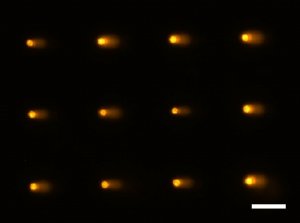May 3 2010
Our DNA is under constant siege from a variety of damaging agents. Damage to DNA and the ability of cells to repair that damage has broad health implications, from aging and heritable diseases to cancer. Unfortunately, the tools used to study DNA damage are quite limited, but MIT researchers have developed a new tool for rapid DNA damage analysis that promises to make an impact on human health.
The researchers, led by Bevin Engelward, MIT associate professor of biological engineering, and Sangeeta Bhatia, professor in the Harvard-MIT Division of Health Sciences and Technology and MIT’s Department of Electrical Engineering and Computer Science, have produced a completely revamped version of a three-decades-old lab test known as the comet assay. This new technique combines the versatility and sensitivity of the comet assay for DNA damage analysis with a robust high-capacity platform, which could make DNA damage analysis routine across a variety of applications, ranging from epidemiology to drug screening.
 Image: David Wood and David Weingeist
Image: David Wood and David Weingeist
Engelward, Bhatia, postdoctoral fellow David Wood and graduate student David Weingeist describe the technique in a paper that will appear in the Proceedings of the National Academy of Sciences the week of May 3.
The technology could offer a new approach for epidemiologists to detect dangerous environmental exposures long before they cause cancer, for clinicians to provide better cancer treatment, and for researchers in the pharmaceutical industry to identify new drugs and screen out hazardous drugs.
How they did it: The comet assay is based on the idea that during gel electrophoresis, a commonly used lab test in which an electric field is applied to DNA placed on a polymer gel, damaged DNA moves farther across the gel than undamaged DNA. The result is a “comet” made of DNA, which looks remarkably like its astronomical namesake. The assay is both sensitive and versatile, but it is also laborious and tedious. It requires at least one microscope slide for every experimental condition, which means that researchers need to juggle dozens of slides just to do a few experimental conditions. Additionally, the readout is entirely manual, meaning researchers have to spend hours staring into a microscope and selecting cells for analysis. The team’s goal was to harness the strengths of the comet assay while overcoming its limitations in throughput and labor.
Using a micopatterning technique developed by Wood and Bhatia, the research team imprinted a grid of tiny wells the size of a single cell on a DNA electrophoresis gel. Cells in the array can be individually “addressed,” which allows fully automated readout and replaces the tedious manual analysis. They also put their micoscopic cell array into a 96-well plate so that many cell types, drugs, or other conditions can be assayed simultaneously.
This setup allows dozens of experimental conditions to be tested on just one slide, and it enables slides to be automatically analyzed using custom-designed imaging software.
Next steps: The team is using knockout cell lines to determine which genetic deficiencies are detectable with their platform and to better understand the molecular mechanisms of DNA repair. They are also optimizing their system for human samples in order to study the DNA damaging effects of the environment. Ultimately, they hope that the CometChip will be commercialized and made available around the world. This technology was designed not only to enable high throughput screening, but also to be compatible with basic laboratory equipment so that virtually any laboratory can use it.
Source: “Single cell trapping and DNA damage analysis using microwell arrays,” Proceedings of the National Academy of Sciences, week of May 3. David Wood, David Weingeist, Sangeeta Bhatia and Bevin Engelward.
Funding: MIT Center for Environmental Health Sciences, the National Institute of Environmental Health Sciences (Program in Gene-Environment Interactions), and the National Institutes of Health.)